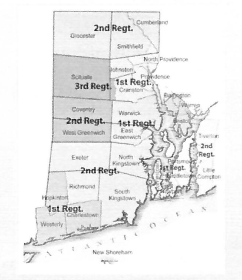With commemoration of the 250th anniversary of the American Revolution beginning with December's remembrance of the 1773 Boston Tea Party, it's a fitting time to remember a few of our many Austin ancestors who served in that defining conflict. One of those who served is my great ×5 grandfather PicusAustin. Picus' service was typical of many young men of that era caught up in these great events because it was that of an ordinary man doing his civic duty, supporting his community, state, and nation's quest for freedom.
Picus Austin was born on March 2, 1740, in South Kingstown, Rhode Island. He was the great grandson of Robert Austin (1634-1687), the first Austin in that line, who emigrated from England. He married Grizell Tourgee on February 17, 1764 and by the 1775 opening of the American Revolution Picus was a 35-year-old farmer and father of seven children.Yet in addition to these responsibilities, Picus was a member of the Rhode Island Militia, serving in the King’s County Regiment.’
Rhode Island’s 1718 Militia Act required men between the ages of 16 and 50 to train as militia infantry soldiers (unless excused and to serve when called upon.
In 1774, just priort o the war’s outbreak, Rhode Island reorganized its militia, using the same manpower pool to create more, smaller regiments. King’s County there- fore created a second regiment-formed of men and companies from North and South Kingstown-named the Second King’s County Regimentand commanded by Colonel Charles Dyer. With the war having begun in earnest with the April 19th, 1775 Battles of Lexington and Con- cord, by August 1776 the Second King’s County Regiment consisted of six companies. This regimental company structure remained unchanged from June 1776 to May 1779, although its commanders changed frequently. By Summer 1780, Major General lames Varnum commanded the Rhode Island Militia and its King’s County troops had been formed into a larger formation, the Kings County Brigade, in part because the King’s County militia had grown so large in number that athird regiment was necessary?
For Picus and other Rhode Island residents the warcame calling in December 1776 when British troops and ships ar- rived to occupy Aquidneck and Conanicut (Jamestown) Islands, where the vital port of Newport was located. Picus’ first militia service ran from June/July to November 1776 in Colonel Charles Dyer’s Second King’s County Regiment, possibly in Samuel Potter’s 1st South Kingstown Company. This period included Picus’ serving on the

“Narragansett shore,” probably as a lookout at Point Judith monitoring the coast and tracking British ships.3
By Summer 1777, theContinental Congress wanted to removethe British threat at Newport and GeorgeWashing- ton assigned Bunker (Breeds) Hill veteran General Joseph Spencer to lead some 10,000 Massachusetts, Connecticut,
and Rhode Island militiatroops – including Private Picus Austin – to drive the Redcoats away. Picus’ second militia
call-up ran from August-November 1777, again with the Second King’s County Regiment but now in the company commanded either bySamuel Potter or Captain Daniel Sherman. In this unit Picus took part In October 1777’s “Spencer’s Expedition” which, despite crossing ontoAquid- neck Island, failed when weather and Spencer’s timid plan and leadership led the Americans to retreat.*
Rhode Island once again rose to prominence after France, in March 1778, declared it would send troops and ships to support the American cause. Although French Ad- miral Comte d’Estaing’s fleet of 12 ships and 4,000 French soldiers sailed shortly thereafter for America, his largest ships were unable to cross the shallow bar into New York harbor, requiring they dock at the nearest suitable harbor – Newport,w h i c h remained under British occupation. In July 1778, the Continental Congress appointed Major Gen- eral John Sullivan to lead an expedition to clear vital New- port of British occupiers.
To provide troops for Sullivan’s Expedition Rhode Island called up its entire militia in early August 1778, including Picus Austin who served from August toNovember 1778. Picus may have remained posted to the Second King’s County Regiment, in companiescommanded either by Samuel Pot- ter or Captain Daniel Sherman. However, he may have served in the new 3rd Kings County Regiment, commanded by L.t Col. Thomas Potter, Regardless which unit he served with, PicusAustin participated in Sullivan’s Expedition and its concluding event, the August 28-29 Battle of Rhode Is- land (also known as the Battle of Newportor Battle of Quaker Hill). Although Sullivan’s Expedition failed to retake Newport–a major hurricane drove away vital French naval support–his troops fought experienced British Regulars and Hessian’s to astalemate, until they withdrew to the Rhose Island mainland ni good order. Despite this result, Picus Austin took part in the first joint Franco-American military campaign of the American Revolution.5 PicusAustin’s last Revolutionary War service occurred from October 8 to November8, 1781, when he onceagain served a sa guard on Rhode Island’s Point Judith, detached from Colonel Christopher Olney’s Regiment of Rhode Island Militia.
Having played his part in securing America’s independ- ence, Picus Austin settled back intolife with his family and farm, a transition certainlyeased by having returned there between each of his periods of militia service.
By 1820, after moving briefly to Tyring- ham, Massachusetts, Picus and Grizell were living in Bennington, New York. On Novem- ber 30, 1826 Picus Austin passed away in Pembroke, New York, and is buried in the County Line Road Adventist Cemetery in Darien, New York.?
In 1840 Grizell Austin (1746-1846) ap- plied for a widow’s pension based on Picus’ Revolutionary War service. During 1840-1841, Grizell and her children Thomas Austin (1766-1852) and Abigail Austin (1765-1853) provided written testimony of Picus’service that included a letter Pics penned before his death, listing his children and their birth dates. However, Grizell never received Picus’ pension and died in 1846. Her daughter Hannah Austin (1786-1853) continued pressing the claim in 1853, adding her and grandson Ira Austin’s remem- brances, as well as testimony by 92-year-old Silas Moore, who had served alongside Picus in the Rhode Island Militia. Although this application alsofailed to secure the family his pension, ti nonetheless provided us, his descendants, a price- less record of Picus Austin’s Revolutionary War service.8

- Edith Austin Moore, A Genealogy of the Descendants of Robert Austin of Kingstown, Rhode Island (St. Petersburg, Florida, 1951), pp. 243-244, 616.
- The Organization of the Rhode Island Militia 1774-1783 -Journal of the American Revolution(allthingsliberty.com).
- Christian M. McBurney, The Rhode Island Campaign: The First French and American Operation in the Revolutionary War (Westholme Publishing, 2011), pp. 1-21; U.S., Compiled Revolutionary War Military Service Records, 1775-1783, Rhode Island, Olney’s Militia, US National Archives.
- McBurney, The Rhode Island Campaign, pp. 22-48; U.S., Compiled Revolutionary War Military Service Records, 1775-1783, Rhode Island, Olney’s Militia, US National Archives.
- U.S., Compiled Revolutionary War Military Service Records, 1775-1783, Rhode Island, Olney’s Militia, US National Archives: McBurney The Rhode Island C a m p a i g n , pp. 148-195; U.S., Compiled Revolutionary War Military Service Records,1775-1783, Rhode Island, Olney’s Militia, US National Archives.
- Record taken from a certificate signed by Sgt. Kazel Smith recording “contents received,” recorded by Edith Austin Moore from a card index in the State House in Providence, R.., noted in A Genealogy of the Descendant of Robert Austin of Kingstown, Rhode Island, p. 616.
- Moore, A Genealogy of the Descendantsof Robert Austin,
Pp. 243-244; Picus Austin- Facts (ancestry.com):
U.S., Find a Grave®Index, 1600s-Current- Ancestry.com. - U.S., Revolutionary War Pension and Bounty-Land Warrant Application Files, 1800-1900, US National Archives.

